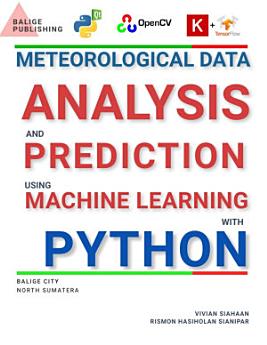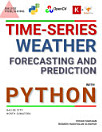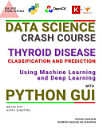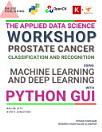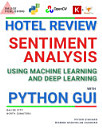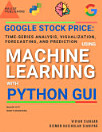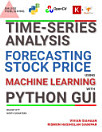METEOROLOGICAL DATA ANALYSIS AND PREDICTION USING MACHINE LEARNING WITH PYTHON
About this ebook
To gain insights into the data, we visualize the distribution of each feature, examining histograms, box plots, and scatter plots. This helps us identify potential outliers and understand the relationships between different variables. After data exploration, we preprocess the dataset, handling missing values through imputation techniques or removing rows with missing data, ensuring the data is ready for machine learning algorithms.
Next, we define the problem we want to solve, which is predicting the weather summary based on various meteorological parameters. The weather summary serves as our target variable, while the other features act as input variables. We split the data into training and testing sets to train the machine learning models on one subset and evaluate their performance on unseen data. For the prediction task, we start with simple machine learning models like Logistic Regression or Decision Trees. We fit these models to the training data and assess their accuracy on the test set.
To improve model performance, we explore more complex algorithms, such as Logistic Regression, K-Nearest Neighbors, Support Vector, Decision Trees, Random Forests, Gradient Boosting, Extreme Gradient Boosting, Light Gradient Boosting, and Multi-Layer Perceptron (MLP). We use grid search to tune the hyperparameters of these models and find the best combination that optimizes their performance.
During model evaluation, we use metrics such as accuracy, precision, recall, and F1-score to measure how well the models predict the weather summary. To ensure robustness and reliability of the results, we apply k-fold cross-validation, where the dataset is divided into k subsets, and each model is trained and evaluated k times. Throughout the project, we pay attention to potential issues like overfitting or underfitting, striving to strike a balance between model complexity and generalization.
Visualizations play a crucial role in understanding the model's behavior and identifying areas for improvement. We create various plots, including learning curves and confusion matrices, to interpret the model's performance. In the prediction phase, we apply the trained models to the test dataset to predict the weather summary for each sample. We compare the predicted values with the actual values to assess the model's performance on unseen data.
The entire project is well-documented, ensuring transparency and reproducibility. We record the methodologies, findings, and results to facilitate future reference or sharing with stakeholders. We analyze the predictive capabilities of the models and summarize their strengths and limitations. We discuss potential areas of improvement and future directions to enhance the model's accuracy and robustness.
The main objective of this project is to accurately predict weather summaries based on meteorological data, while also gaining valuable insights into the underlying patterns and trends in the data. By leveraging machine learning algorithms, preprocessing techniques, hyperparameter tuning, and thorough evaluation, we aim to build reliable models that can assist in weather forecasting and analysis.
Ratings and reviews
- Flag inappropriate
- Show review history
- Flag inappropriate
- Flag inappropriate
About the author
Vivian Siahaan is a fast-learner who likes to do new things. She was born, raised in Hinalang Bagasan, Balige, on the banks of Lake Toba, and completed high school education from SMAN 1 Balige. She started herself learning Java, Android, JavaScript, CSS, C ++, Python, R, Visual Basic, Visual C #, MATLAB, Mathematica, PHP, JSP, MySQL, SQL Server, Oracle, Access, and other programming languages. She studied programming from scratch, starting with the most basic syntax and logic, by building several simple and applicable GUI applications. Animation and games are fields of programming that are interests that she always wants to develop. Besides studying mathematical logic and programming, the author also has the pleasure of reading novels. Vivian Siahaan has written dozens of ebooks that have been published on Sparta Publisher: Data Structure with Java; Java Programming: Cookbook; C ++ Programming: Cookbook; C Programming For High Schools / Vocational Schools and Students; Java Programming for SMA / SMK; Java Tutorial: GUI, Graphics and Animation; Visual Basic Programming: From A to Z; Java Programming for Animation and Games; C # Programming for SMA / SMK and Students; MATLAB For Students and Researchers; Graphics in JavaScript: Quick Learning Series; JavaScript Image Processing Methods: From A to Z; Java GUI Case Study: AWT & Swing; Basic CSS and JavaScript; PHP / MySQL Programming: Cookbook; Visual Basic: Cookbook; C ++ Programming for High Schools / Vocational Schools and Students; Concepts and Practices of C ++; PHP / MySQL For Students; C # Programming: From A to Z; Visual Basic for SMA / SMK and Students; C # .NET and SQL Server for High School / Vocational School and Students. At the ANDI Yogyakarta publisher, Vivian Siahaan also wrote a number of books including: Python Programming Theory and Practice; Python GUI Programming; Python GUI and Database; Build From Zero School Database Management System In Python / MySQL; Database Management System in Python / MySQL; Python / MySQL For Management Systems of Criminal Track Record Database; Java / MySQL For Management Systems of Criminal Track Records Database; Database and Cryptography Using Java / MySQL; Build From Zero School Database Management System With Java / MySQL.
Rismon Hasiholan Sianipar was born in Pematang Siantar, in 1994. After graduating from SMAN 3 Pematang Siantar 3, the writer traveled to the city of Jogjakarta. In 1998 and 2001 the author completed his Bachelor of Engineering (S.T) and Master of Engineering (M.T) education in the Electrical Engineering of Gadjah Mada University, under the guidance of Prof. Dr. Adhi Soesanto and Prof. Dr. Thomas Sri Widodo, focusing on research on non-stationary signals by analyzing their energy using time-frequency maps. Because of its non-stationary nature, the distribution of signal energy becomes very dynamic on a time-frequency map. By mapping the distribution of energy in the time-frequency field using discrete wavelet transformations, one can design non-linear filters so that they can analyze the pattern of the data contained in it. In 2003, the author received a Monbukagakusho scholarship from the Japanese Government. In 2005 and 2008, he completed his Master of Engineering (M.Eng) and Doctor of Engineering (Dr.Eng) education at Yamaguchi University, under the guidance of Prof. Dr. Hidetoshi Miike. Both the master's thesis and his doctoral thesis, R.H. Sianipar combines SR-FHN (Stochastic Resonance Fitzhugh-Nagumo) filter strength with cryptosystem ECC (elliptic curve cryptography) 4096-bit both to suppress noise in digital images and digital video and maintain its authenticity. The results of this study have been documented in international scientific journals and officially patented in Japan. One of the patents was published in Japan with a registration number 2008-009549. He is active in collaborating with several universities and research institutions in Japan, particularly in the fields of cryptography, cryptanalysis and audio / image / video digital forensics. R.H. Sianipar also has experience in conducting code-breaking methods (cryptanalysis) on a number of intelligence data that are the object of research studies in Japan. R.H. Sianipar has a number of Japanese patents, and has written a number of national / international scientific articles, and dozens of national books. R.H. Sianipar has also participated in a number of workshops related to cryptography, cryptanalysis, digital watermarking, and digital forensics. In a number of workshops, R.H. Sianipar helps Prof. Hidetoshi Miike to create applications related to digital image / video processing, steganography, cryptography, watermarking, non-linear screening, intelligent descriptor-based computer vision, and others, which are used as training materials. Field of interest in the study of R.H. Sianipar is multimedia security, signal processing / digital image / video, cryptography, digital communication, digital forensics, and data compression / coding. Until now, R.H. Sianipar continues to develop applications related to analysis of signal, image, and digital video, both for research purposes and for commercial purposes based on the Python programming language, MATLAB, C ++, C, VB.NET, C # .NET, R, and Java.
